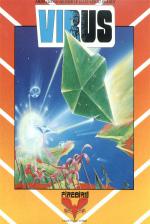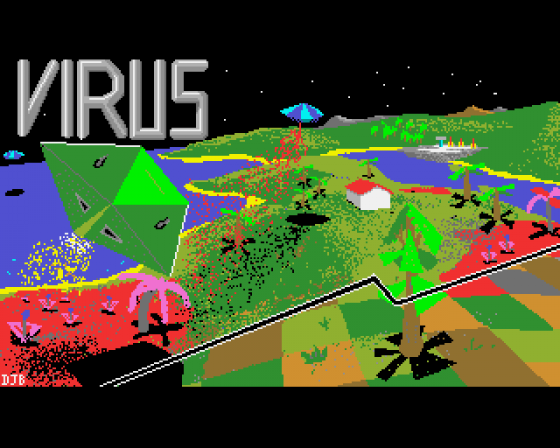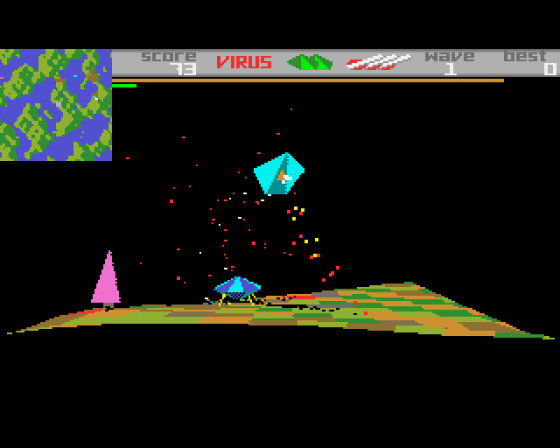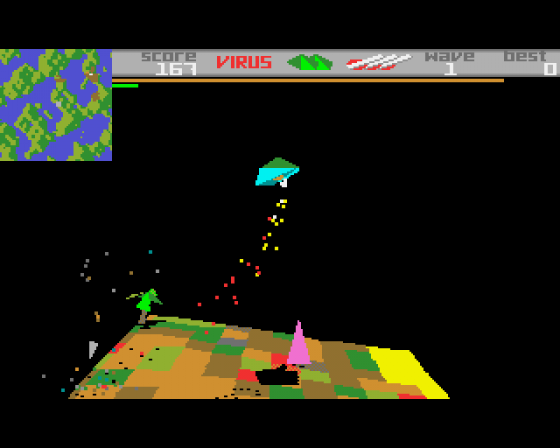
Commodore User
 1st September 1988
1st September 1988
Categories: Review: Software
Author: Gary Whitta
Publisher: Firebird
Machine: Amiga 500
Published in Commodore User #61
Virus
For a man who's only ever produced two games, David Braben has got one hell of a reputation as a programmer. He designed and co-wrote the timeless classic Elite, and more recently (about a year ago in fact) conceived and wrote Zarch for Acorn's mighty 32-bit mega-machine, the Archimedes.
Zarch's astounding graphics and gameplay caused it to be instantly heralded as a classic among classics and so, not surprisingly, Firebird snapped up the conversion rights the moment they saw it. After several months' development, the official Amiga version has finally arrived under the name of Virus, and it's nothing short of fantastic.
Set in the not-too-distant future, the game takes place over a large colony of islands under attack by a sinister race of aliens, who are spreading an evil red virus across the countryside which pollutes and destroys plant life. Since the island colonists depend on their crops to survive, all their lives are at risk. The only way the aliens can be stopped is to attack them head-on using a hoverplane - a kind of futuristic jet fighter.
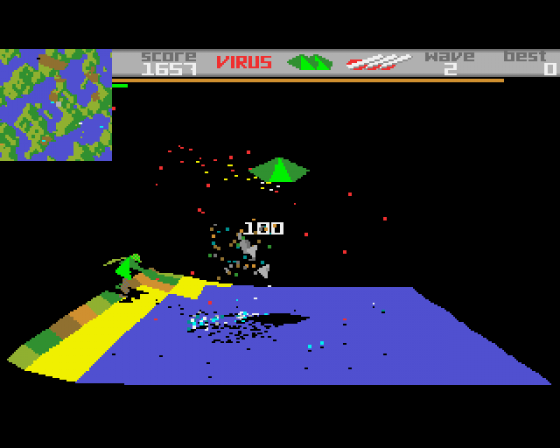
As you may have guessed, Virus is a shoot-'em-up. Nothing special there. What sets it apart from all other games is the way in which it's presented. Virus employs a revolutionary solid 3D graphics technique to display the game world in the most convincing manner yet to be seen in a computer game.
The hoverplane is viewed from the outside and operates on a remarkably simple 'tilt and burn' system. The ship, which looks rather like a squashed and elongated pyramid, has an engine situated at the base of the craft. Applying thrust forces the hoverplane straight up as a stream of highly-coloured vapour shoots out from the exhaust port. Pushing the mouse forward and back will raise and lower the plane's nose, while left and right movements spin it round through 360 degrees. In this manner, it's possible to tilt the plane at every conceivable angle and so travel in any direction you please. It's like Thrust with an extra dimension.
Learning to control the plane properly is a task that requires days of solid practice and plenty of patience.
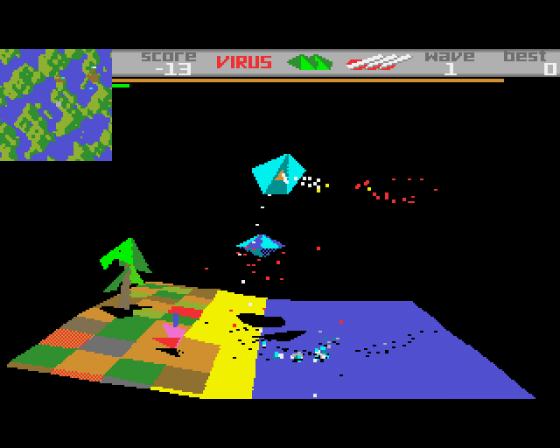
The countryside is represented as an undulating series of hills and dips, broken down into many different coloured rectangles to give a lovely rural patchwork effect. Trees, houses and rotating radar towers make regular appearances on the landscape and help to make the whole thing more interesting graphically. Travelling between islands is not a problem, simply a matter of flying over the expanses of water that segregate them, and navigation aid is provided in the form of a map of the entire game area pinpointing your position at all times. The length of time you can thrust around is dictated by your fuel level, which dwindles away as you fly, and can only be replenished by returning to your home base.
The virus-spreading aliens begin to appear shortly after take-off, and are split into eight specific types, each with their own characteristics. Airborne nasties such as the drones and pests fly randomly about the landscape, shooting away and generally being a nuisance. Thankfully these don't cause too much trouble. It's the ones that actually distribute the evil red virus that must be destroyed. Seeders, for example, wander around the landscape, spurting out deadly red dust wherever they go, while bombers drop virus cannisters from a great height onto the landscape below. Even though neither of these two will attack you, they must be killed immediately before they can pollute too much of the countryside, turning it a grisly red/brown colour, and any trees in the vicinity into strange hybrids. The aliens can be shot down using the nose-mounted cannon. Nastier types can be knocked out by firing one of the hoverplane's three homing missiles.
Defending the islands in this manner continues until the designated number of aliens have been destroyed, whereupon the current attack wave ends and bonus points are allocated for amount of area that remains uninfested. The next attack wave brings more aggressive opponents, and more of them as well. Extra features to make life harder are added as the game progresses, such as higher levels of gravity, which means more thrust has to be used to keep the hoverplane airborne, at the expense of more fuel.
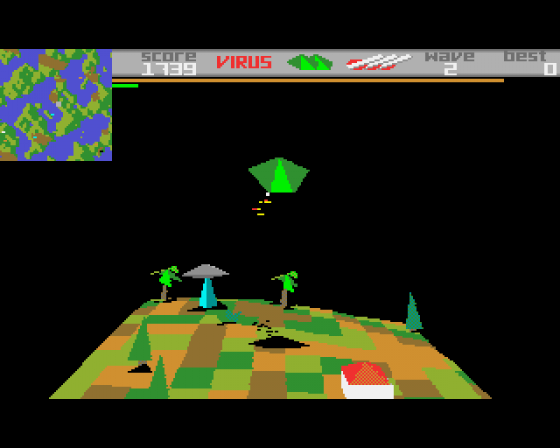
Graphically Virus is a masterpiece. The amazing attention to detail makes it one of the most attractive Amiga games yet to appear. Everything is faultless, from the way the landscape rises and falls smoothly under you as you glide past, to the way in which everything in the game, right down to the vapour trails from your own craft and the smoking remains of destroyed alien craft casts a perfect shadow on the landscape. Fly too high and you'll find a beautiful multi-layer parallax starfield. True, the game isn't quite as colourful as the Archie original, and some of the fancier graphic frills have had to be omitted, but that was only to be expected.
Sound is adequate, with the lack of music being made up for by excellent thrusting effects and a gorgeous sampled splash when vapour trails hit the water. All this, however simply pales away when compared to the sheer genius of the gameplay itself. There's a lot of solid practising to be done before the pig of a control method is grasped, but once it is I defy anyone to leave the game alone for more than an hour.
Virus is so simple and yet so innovative that it completely changes the face of the shoot-'em-up as we know it.
Starting Up
- Learn to use thrust correctly. Constant thrusting results in rapid fuel loss and makes the hoverplane much harder to steer, so thrust a little and fly on momentum until you begin to drop. Then thrust a little more to keep moving.
- Remember where your home base is (in the exact centre of the map) and practise landing to refuel until you have perfected it.
- Watch the demo! The computer is an excellent pilot and you can pick up some great combat manoeuvres by watching it carefully.
- Don't fire the cannons just for the sake of it. Every bullet that misses results in a point being subtracted from your score.
- Be careful and have lots of fun. [What kind of tip do you call this?! - Ed]
Other Reviews Of Virus For The Amiga 500
Virus (Firebird)
A review
Virus (Firebird)
A review by Julian Rignall (C&VG)

